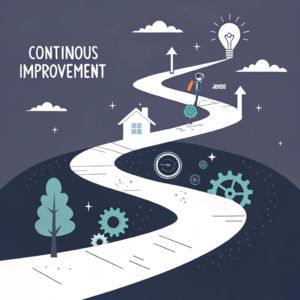Managing product information can be a significant challenge for small and medium-sized enterprises (SMEs). Inefficient management of product data can lead to confusion, errors, and missed opportunities. For C-level executives who focus on strategic growth and operational efficiency, understanding how to effectively manage a Product Information Management (PIM) system is crucial. Governance plays a key role in this process.
Governance in the context of a PIM system involves a set of policies, processes, and structures that ensure effective and efficient management of product information. Here are the key aspects of governance that every SME executive should consider:
Policy Development and Compliance
Governance starts with clear guidelines and policies for managing product information. This involves establishing procedures that describe the lifecycle of product data, from creation to publication and archiving. A solid policy not only helps with internal consistency but also ensures that the company complies with legal requirements and industry standards. This prevents costly mistakes and increases the reliability of the data.

Data Quality Assurance
Ensuring data quality is a core component of governance. This includes defining standards for data entry, validation processes, and regular audits. Good data quality assurance means that product information is accurate, consistent, and up-to-date. This is vital for making informed business decisions and maintaining customer trust.

Roles and Responsibilities
An effective governance model clearly defines the roles and responsibilities of everyone involved in the PIM system. This helps prevent overlaps and gaps in responsibilities, which can lead to errors and inefficiencies. By clarifying who is responsible for which aspects of product information, companies can improve performance and accountability.

Workflow and Approval Processes
Streamlined workflows and approval processes are essential for managing product information. Governance ensures that these processes are well-designed and followed. This means that new or updated information is reviewed and approved before it is published. Efficient workflows reduce the likelihood of errors and ensure that product information is updated quickly and accurately.

Security and Access Control
Managing security protocols and access rights is a critical aspect of governance. This protects sensitive product information from unauthorized access and misuse. By setting clear access controls, companies can ensure the integrity and confidentiality of their data. This is especially important in industries where data security is a priority, such as healthcare and financial services.

Continuous Improvement
A culture of continuous improvement is essential for effective governance. This means regular evaluations and adjustments to processes and systems to meet changing business needs and technological advancements. By continually seeking ways to improve, companies can optimize their PIM systems and drive innovation.

Training and Support
Training employees in the use of the PIM system and providing ongoing support is another crucial aspect of governance. This ensures that everyone in the company is proficient in managing product information and stays up-to-date with best practices and new functionalities. Well-trained employees can better contribute to the efficiency and accuracy of the PIM system.

The Benefits of Good Governance in PIM
Implementing effective governance in a PIM system offers numerous benefits for SMEs:
- Improved Data Quality: Accurate and consistent product information enhances decision-making and increases customer satisfaction.
- More Efficient Processes: Streamlined workflows and clear roles reduce the likelihood of errors and speed up time-to-market.
- Compliance and Risk Management: Adherence to laws and regulations protects the company from legal and financial risks.
- Enhanced Security: Protection of sensitive data prevents breaches and increases the trust of customers and partners.
- Culture of Innovation: Continuous improvement and training foster innovation and adaptability.
Strategies for Successful Implementation
To realize the benefits of governance in a PIM system, C-level executives of SMEs should consider the following strategic steps:
- Stakeholder Engagement: Ensure that all relevant stakeholders are involved in the development and implementation of governance policies. This promotes buy-in and ensures that policies are realistic and actionable.
- Investing in Technology: Choose a PIM system that is flexible and scalable, so it can grow with the company. Invest in technologies that integrate with existing systems and enable process automation.
- Change Management: Implementing governance and a PIM system can bring significant changes. Effective change management helps manage resistance and ensures a smooth transition.
- Monitoring and Evaluation: Set up systems for continuous monitoring and evaluation of the PIM system’s performance and governance processes. Use these insights to make improvements.
- Training and Development: Invest in the training and development of employees to ensure they have the skills needed for effective product information management. This includes both initial training and ongoing development opportunities.
Rounding up
For SMEs, managing product information is a complex but crucial task. By implementing effective governance in their PIM systems, companies can not only improve the quality and consistency of their product data but also increase their operational efficiency and comply with legal requirements. This results in better business decisions, increased customer satisfaction, and a stronger market position.

C-level executives should not view governance as an administrative burden but as a strategic opportunity to transform their company. With the right approach, governance in PIM systems can lead to sustainable growth and success. By investing in policy development, data quality, security, workflows, and training, companies can get the most out of their PIM systems and stand out in a competitive market.
By prioritizing governance, SMEs can overcome the challenges of product information management and realize their full potential. This requires dedication, strategic planning, and a culture of continuous improvement. But the rewards – from improved efficiency and compliance to increased customer satisfaction and market success – are well worth the effort.
With these insights and strategies, C-level executives of medium-sized companies can ensure that their PIM systems are not just an operational tool but a driving force behind their strategic goals and business ambitions. Implementing effective governance is the key to unlocking these opportunities and achieving sustainable success in the dynamic world of product information management.
Join our newsletter
Be the first to know about Product Information Management news, helpful tips, and updates!
Join

